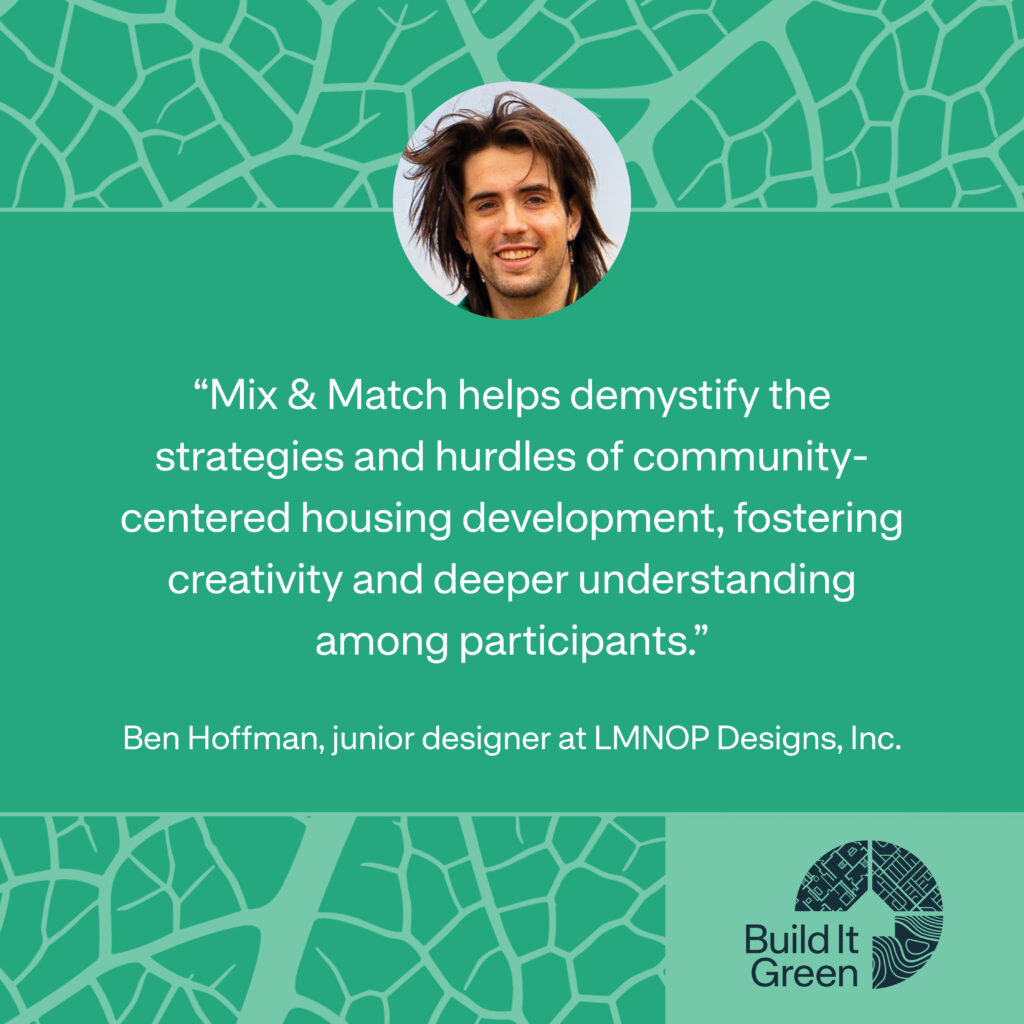Fostering creative, community-driven approaches is key to transforming the housing landscape. That’s why we were excited to co-host the virtual event, “Mix & Match: Building Housing Solutions One Card at a Time,” featuring the designers of Mix & Match, Ben Hoffman, Junior Designer at LMNOP Designs, Inc., and Janette Kim, Principal at All of the Above. The event spotlighted the Mix & Match Toolkit, a board game that helps community members envision and create tailored housing solutions..
A Deeper Look at Mix & Match
Engaging minds at the University of Pennsylvania: participants dive into a live gameplay session of the Mix & Match toolkit, exploring community-centered housing solutions through interactive discussion and strategy.
The Mix & Match project is one of the 2024 Innovation Fund awardees, recognized for its potential to reshape housing conversations in California. As Cerena Harrison, Director of Programs at Build It Green, shared during the event, the toolkit was initially designed to address housing challenges in Plumas County after the 2021 Dixie Fire, helping a community navigate the many choices they’d need to make together to identify what they value and what that would mean for their built environment. Supported by Build It Green’s Innovation Fund, the game has since expanded to reach more communities across the state, promoting a collaborative approach to housing development and community input gathering.

Hoffman and Kim walked participants through the game’s history and mechanics. They emphasized that the game isn’t about finding a singular solution, but about exploring a range of possibilities for what a community could choose to become and what it wants to build. As Hoffman noted, “Mix & Match helps demystify the strategies and hurdles of community-centered housing development, fostering creativity and deeper understanding among participants.”
Interactive Gameplay and Community Input
During the session, participants engaged with the game’s virtual version. Using a blend of pre-set scenarios and live interaction, Hoffman and Komoda Kim led attendees through designing a housing solution for a fictional community. The event replicated the dynamic in-person experience, where players explore different housing, ownership, and financing models to fit their community’s specific needs — in this case a place facing rising housing costs with limited housing availability.
When participants reached the stage of choosing a housing model, their options included pocket neighborhoods, accessory dwelling units, and multi-family housing. After a thoughtful discussion, the group ultimately voted for multi-family housing, prioritizing the need for greater density and affordability to accommodate a variety of residents.
In the next phase, focused on financing, attendees explored the trade-offs between different funding sources. They debated the advantages of Community Investment Funds, which allow for local-driven financial support, versus government land transfers that could reduce upfront costs. Many attendees leaned toward the potential of community-based capital raising, appreciating its alignment with local engagement and resilience that they could imagine for this fictional community. When played with stakeholders in a real place, these factors would be important to explore to understand what actual possibilities are on the table.
In this gameplay moment, participants discuss creative strategies for homeownership and community growth, exploring sweat equity, land use, and gradual densification.
During Mix & Match gameplay, participants discuss and strategize on building a housing plan that truly meets community needs by exploring varied housing types while emphasizing the power of inclusive and balanced neighborhood design.
Kim emphasized that the game’s flexibility enables players to revisit and adjust their choices as they understand the implications of each model, and what would be needed to adapt to a specific place and community’s needs. She explained, “This is a game of trial and error—it’s less about winning and more about sparking creative conversations and learning together.”
Looking Ahead: Expanding the Toolkit’s Impact
As the event concluded, the conversation shifted to the future of the Mix & Match Toolkit. Thanks to our support, the toolkit will expand statewide, offering workshops and making game sets available on loan to interested communities. This next phase aims to engage underrepresented groups, empowering them to lead in designing housing models that reflect their aspirations and needs.

Hoffman and Kim expressed gratitude for the attendees’ engagement and thoughtful contributions during the session. As Hoffman summarized, “Mix & Match is about more than just housing—it’s about fostering deeper connections between people and building a foundation for equitable, regenerative communities.”
For more information about Build It Green’s programs, email [email protected]. For details on the Mix & Match Toolkit, contact [email protected] or [email protected].


Alex Coba
Communication Associate
As a proud California native from Stockton, Alex brings a wealth of experience and a versatile skill set. He has a solid communication background with a Bachelor of Arts in Journalism and Public Relations from California State University, Chico. Alex is adept at strategic communications and media relations, with experience gathering and sharing stories from his local communities that uplift the unique spirit and values of those places. He is excited to join Build It Green, where he can apply his talents to further BIG’s mission to help communities across California thrive